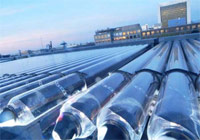A proposed Central Valley power plant will tap three potent sources of renewable energy at once - the sun, crop stubble and cow manure.
The plant, near the old oil-patch town of Coalinga in Fresno County, will combine a large solar farm with a generator that burns orchard trimmings, agricultural waste and, yes, excrement.
Pacific Gas and Electric Co. has announce Thursday that it will buy electricity from the plant, which will be built by Martifer Renewables, a U.S. subsidiary of a Portuguese company. Terms of the deal have not been disclosed.
The plant's design will allow it to do something not typically associated with solar power. It will keep running, and generating power, at night.
"Renewable power doesn't have to be something that only works when the wind is blowing or the sun is shining," said Andrew Byrnes, a member of the power plant's development team at Spinnaker Energy, which is working with Martifer on the project. "It can be a combination of things. Putting them together is just a step in the process."
Some solar plants have backup generators burning natural gas to keep power levels steady on cloudy days. Byrnes believes the Coalinga plant will be the first to use biomass instead of fossil fuel.
As California tries to increase its use of renewable power, it has increasingly turned to solar as a solution.
Large solar farms use mirrors to focus sunlight on liquid-filled tubes, producing steam that can turn a turbine and generate electricity. Called solar thermal or concentrated solar, this technology can produce far more power than the solar panels homeowners install on their roofs.
The Coalinga project will be able to generate a maximum of 107 megawatts of electricity, enough for roughly 80,000 homes. Rows of mirrors will cover almost 640 acres. The project could be built as soon as 2011.
Solar thermal plants using the same technology have been running in the Southern California desert since the 1980s, and many others are under development. PG&E, based in San Francisco, has signed contracts with solar- plant developers to buy as much as 1,736 megawatts of electricity, enough for 1.3 million homes.
Under California law, the state's utilities must ensure by the end of 2010 that 20 percent of the electricity they sell comes from renewable resources.
The Coalinga plant should have plenty of fuel. The town, built after an oil well there spouted a gusher in 1897, sits in a dry valley with steady sunshine and little rain.
Local orchards and fields can provide plenty of biomass for the plant's generator to burn. And the area has no shortage of cattle.
"There's an abundance of material around there, I'm told," said PG&E spokeswoman Jennifer Zerwer.

